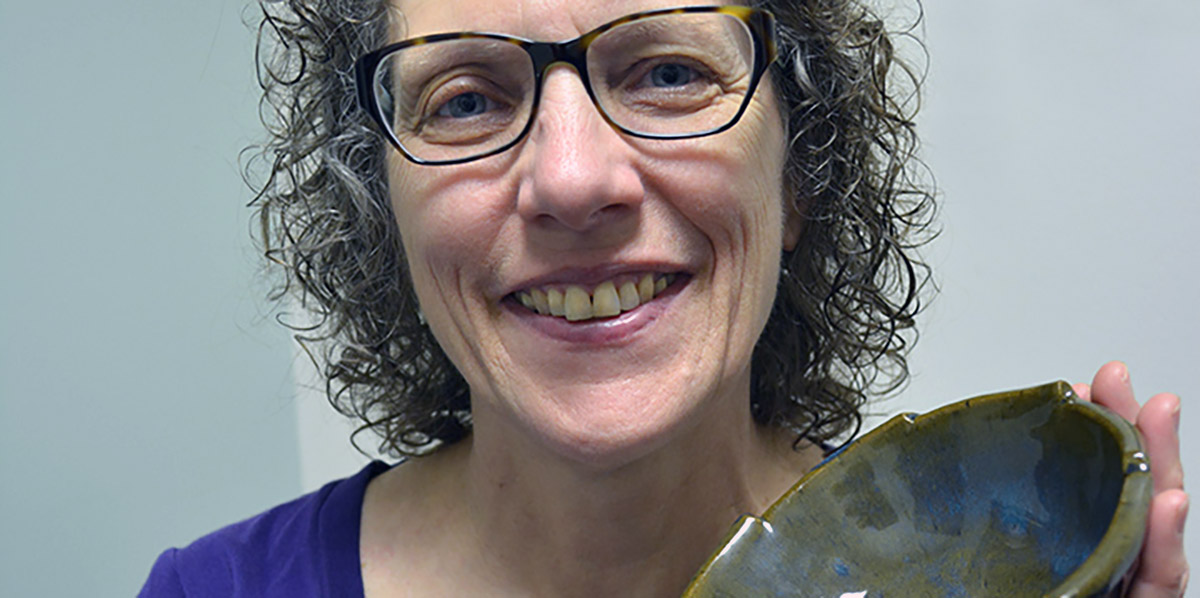- Future Students
- How to Apply
- Visit UHCL
- Admitted Students
- Tuition, Costs and Aid
- Degrees and Programs
- Contact Admissions
- Current Students
- Class Schedule
- Academic Calendar
- Advising
- Events
- Library
- Academic Resources and Support
- Student Services and Resources
- Alumni
- Lifetime Membership
- Alumni Events
- Update Your information
- Awards and Recognitions
- Give to UHCL
UHCL ceramist makes 107 bowls for Houston Food Bank fundraiser
May 9, 2017 | Jim Townsend

Ceramist and University of Houston-Clear Lake Art Gallery Assistant Director Karen Fiscus holds the last of 107 bowls she made to be sold in the annual fundraiser, Empty Bowls Houston, benefiting the Houston Food Bank. The bowl marks the sixth year she has participated with area artists in the 100 Bowl Challenge in support of the fundraising event.
For her sixth year, University of Houston-Clear Lake Art Gallery Assistant Director Karen Fiscus joined other Houston-area ceramists in accepting ClayHouston’s challenge to create 100 soup bowls to be sold in an annual fundraiser, Empty Bowls Houston, benefiting the Houston Food Bank. She made 107.
Since 2004, Empty Bowls Houston – a grassroots effort by area artists, craftspeople, teachers and students – has raised more than $745,000 for the Houston Food Bank, enabling it to provide more than 2.2 million meals. ClayHouston, of which Fiscus is a member, created the yearly 100 Bowl Challenge to encourage support for the fight against hunger, as well as raise awareness for local arts.
This year’s Empty Bowls Houston is Saturday, June 3, 11 a.m. – 3 p.m., at the Houston Center for Contemporary Craft, 4848 Main St. in Houston’s Museum District. In years past, hundreds of supporters have lined the street before the event for the opportunity to purchase the best of hundreds of bowls, Fiscus said.
“Sometimes I’ll take a bowl down the line and entertain them by showing off a bowl. And usually somebody comes in and says, ‘I want that bowl you showed me,’” she said.
For a minimum $25 donation, supporters can select from hundreds of one-of-a-kind, handcrafted bowls. All proceeds go to Houston Food Bank. All unsold bowls are sold by the food bank at other fundraisers. Ceramists and other craft artists will provide demonstrations. Whole Foods Market will provide soup, “served in cups,” Fiscus said. “The bowls aren’t washed.”
All her bowls are dishwasher-safe, although she acknowledges that some buy her bowls to display, not to use. That’s fine with her, she said. “I create art for the table.”
She said it took about two months to make 107 bowls, including a lot of patience and passion for her art. She threw 50 bowls over the President’s Day three-day weekend in February, turning each on her potter’s wheel. It took all of March and most of April to complete the project, she said.
“I first measure out clay balls of the same weight, so that all the pieces will be relatively the same size. I can sit down and throw 25 bowls at a time. Then they have to dry. Then I turn them over and let them dry some more. It usually takes a day or so to do that.”
The bowls aren’t totally dry at this point – just dry enough to hold their shape. Then she trims off excess clay.
“It actually takes me longer to trim than it does to throw,” she said.
She forms different lips on the bowls, employing various techniques she’s learned over the years.
“I threw my first bowl in 1971, in high school,” she said. She received a master’s degree in Humanities from UHCL in 2012.
She forms a “foot ring” on the bottom of each bowl. She dimples the ring’s rim to facilitate drainage when the bowls are placed upside down in the dishwasher, which also forms a distinguishing “signature” of her work. “I was looking at the dishwasher and thinking this was so annoying having to dump the water out of the foot,” she said, describing her “aha” moment. “It was like, ‘I can do something about that!’”
Once the bowls are dry, they are “bisque-fired” at 1,200 F -1,500 F in an electric kiln, which steams the remaining moisture out of the clay and transforms the pieces to a porous state so they can be glazed. Fiscus can bisque-fire up to 30 bowls at once.
The fine-ground glaze material is mixed with water.
“When you glaze the piece, the porousness of it absorbs the water and places a layer of glaze over the piece. You can dip it, paint it or spray it on.”
Fiscus’ preferred method is dipping.
Once the glaze is applied, the piece is glaze-fired at a temperature that depends on the glaze. Fiscus’ glaze-fired her bowls at about 2,000 F - 2.200 F – 25-30 at a time. This part of the process took about 12-17 hours to warm-up to the peak temperature, followed by a two-day cool-down to room temperature.
“You don’t want to open the kiln and have them all crack. You have to be patient. It’s not like baking cookies. You can’t take them out hot.”
Each piece is unique and can be purchased for a $25 donation at the Empty Bowls Houston event. The love put into each bowl’s creation is free, Fiscus says.
“When I first started selling my pots at craft fairs, I had a little sign that said, ‘Each pot has a little love thrown in.’,” she said.
For more information about the event, the bowls or the UHCL Art Gallery, call Fiscus at 281-283-3311.






